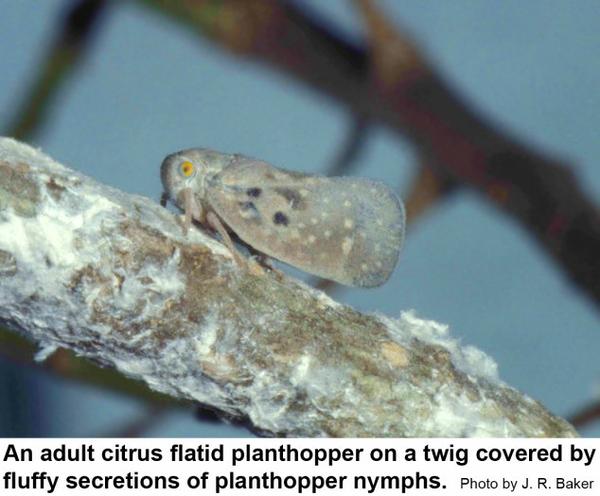Description and Biology
The most common flatid planthopper in North Carolina is the citrus flatid planthopper, Metcalfa pruinosa. The citrus flatid planthopper is dark bluish-black but has a white, waxy bloom that makes the insect appear whitish or bluish-white. The eyes are orange or reddish. The 1/4 inch long adults appear during the summer. Female planthoppers insert eggs into the bark of the current year's growth where the eggs spend the winter. Nymphs hatch next spring and summer and feed by sucking sap through needle-like mouthparts they jab into the bark or leaf. As the nymphs feed, they secrete a white, fluffy secretion that covers their bodies and the twigs or leaves around it. Flatid planthopper nymphs grow to 3/16 inch long. Development from egg to adult takes a little over 5 months. Nymphs are pale green with red eyes and covered by a thick, fluffy, white, waxy secretion that also covers the stem in a sort of "nest." Nymphs are wide and flat. They can jump 12 to 18 inches when disturbed, hence the name planthopper. We have only one generation per year in North Carolina.
Host Plants
Flatid plant-hoppers feed on numerous trees, vines, and ornamental herbs. They are commonly reported on shrubs in North Carolina. Flatid planthoppers are usually not abundant enough to cause real damage to the health of ornamental plants. Their waxy secretions and the honeydew they excrete disfigure plants and make them sticky to touch. Sooty molds may grow in the honeydew, further disfiguring infested plants. Rarely are planthoppers abundant enough to kill twigs by feeding or by egg deposition under the bark.
Residential Recommendation
Planthoppers and their nymphs can be dislodged by spraying infested shrub with a stream of water from a garden hose. No insecticide is specifically labeled for planthoppers, but contact pesticides such as pyrethroids applied for other labeled pests should more than adequately suppress planthoppers.
References
- Common name: citrus flatid planthopper, scientific name: Metcalfa pruinosa (Say) (Insecta: Hemiptera: Flatidae). Mead, F. W. 2017 (reviewed). Featured Creatures, Entomol.& Nematol. FDACS/DPI, Univ. Florida. Pub. No. EENY-329.
- Life histories of Anormenis septentrionalis, Metcalfa pruninosa, and Ormenoides venusta with descriptions of immature stages. Wilson, S. W. and J. E. McPherson. 1981. Ann. Entomol. Soc. Amer. 74 (3): 299-311.
- Planthoppers. Frank, S. D., J. R. Baker and S. B. Bambara. 2000. Entomology Insect Notes, NC State Extension Publications.
- Planthoppers: their ecology and management. Denno, R. F. and T. J. Perfect. 1994. Chapman & Hall, New York. X + 799 pp.
- Extension Plant Pathology Publications and Factsheets
- Horticultural Science Publications
- North Carolina Agricultural Chemicals Manual
For assistance with a specific problem, contact your local N.C. Cooperative Extension Center
This Factsheet has not been peer reviewed.
Publication date: Dec. 13, 2013
Revised: Sept. 11, 2019
Recommendations for the use of agricultural chemicals are included in this publication as a convenience to the reader. The use of brand names and any mention or listing of commercial products or services in this publication does not imply endorsement by NC State University or N.C. A&T State University nor discrimination against similar products or services not mentioned. Individuals who use agricultural chemicals are responsible for ensuring that the intended use complies with current regulations and conforms to the product label. Be sure to obtain current information about usage regulations and examine a current product label before applying any chemical. For assistance, contact your local N.C. Cooperative Extension county center.
N.C. Cooperative Extension prohibits discrimination and harassment regardless of age, color, disability, family and marital status, gender identity, national origin, political beliefs, race, religion, sex (including pregnancy), sexual orientation and veteran status.



